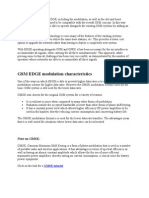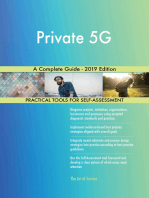Step I - Primary Synchronization Signal (PSS)
Step I - Primary Synchronization Signal (PSS)
Uploaded by
kylzsengCopyright:
Available Formats
Step I - Primary Synchronization Signal (PSS)
Step I - Primary Synchronization Signal (PSS)
Uploaded by
kylzsengOriginal Title
Copyright
Available Formats
Share this document
Did you find this document useful?
Is this content inappropriate?
Copyright:
Available Formats
Step I - Primary Synchronization Signal (PSS)
Step I - Primary Synchronization Signal (PSS)
Uploaded by
kylzsengCopyright:
Available Formats
LTE Access & Transmission Procedures
1-Cell Search & Selection:
Step I Primary Synchronization Signal (PSS) The UE first looks for the primary synchronization signal (PSS) which is transmitted in the last OFDM symbol of the first time slot of the first sub frame (sub frame 0) in a radio frame. This enables the UE to acquire the slot boundary independently from the chosen cyclic prefix selected for this cell
Step II Secondary Synchronization Signal (SSS) After the mobile has found the 5 ms timing, the second step is to obtain the radio frame timing and the cells group identity. This information can be found from the SSS. In the time domain, the SSS is transmitted in the symbol before the PSS.
2-Derive System Information:
Master Information Block: The MIB includes a limited number of most essential and most frequently transmitted parameters that are required to acquire other information from the cell. MIB uses a fixed schedule with a periodicity of 40 ms and repetitions made within 40 ms. The first transmission of MIB is scheduled at sub frame #0 of radio frame for which SFN mod 4 = 0, and repetition are scheduled at sub frame #0 for all other radio frames.
3-Random Access: The random access procedure is used to request initial access, as part of handover, or to reestablish uplink synchronization. 1-Preamble takes 6 adjacent resource blocks , The subframe and the format which the preamble is sent is determined by System info. Block 2 . It uses Zadoff-Chu sequence , there are also 5 formats the first 4 is used for FDD & TDD and the 5th is used only for TDD , The Preamble allows the eNodeB to estimate the transmission timing of the terminal. If there is no response the UE will increase the preamble power . 2 -Response to the preamble on the DL-SCH , The network is transmitting a timing advance command to adjust the terminal transmit timing, based on the timing estimate in the first step Initial uplink resource grant(required in transmission in step 3), Assignment of temporary identity . 3- UE will (for initial access) send an RRC CONNECTION REQUEST message (transmission of the mobile-terminal identity to the network ) on the uplink common control channel (CCCH), based on the uplink grant received in step 2, Scheduling request . 4- Contention resolution is done, by mirroring back in the uplink CCCH service data unit (SDU) received in step 3. The message is sent on DL-SCH and addressed to the UE via the temporary CRNTI. When the received message matches the one sent in step 3, the contention resolution is considered successful.
You might also like
- Network Segmentation Strategy A Complete Guide - 2021 EditionFrom EverandNetwork Segmentation Strategy A Complete Guide - 2021 EditionNo ratings yet
- Indoor Radio Planning: A Practical Guide for 2G, 3G and 4GFrom EverandIndoor Radio Planning: A Practical Guide for 2G, 3G and 4GRating: 5 out of 5 stars5/5 (1)
- MDT Presentation Set 2Document6 pagesMDT Presentation Set 2PNG networksNo ratings yet
- T150 Users ManualDocument265 pagesT150 Users ManualPhan MHanhNo ratings yet
- LTE-PHY-PRACH-White PaperDocument30 pagesLTE-PHY-PRACH-White Paperpavansrinivasan100% (3)
- MIB & SIB Nokia LTE PDFDocument14 pagesMIB & SIB Nokia LTE PDFDhiraj SinghNo ratings yet
- VoLTE and ViLTE: Voice and Conversational Video Services over the 4G Mobile NetworkFrom EverandVoLTE and ViLTE: Voice and Conversational Video Services over the 4G Mobile NetworkNo ratings yet
- Understanding UMTS Radio Network Modelling, Planning and Automated Optimisation: Theory and PracticeFrom EverandUnderstanding UMTS Radio Network Modelling, Planning and Automated Optimisation: Theory and PracticeMaciej NawrockiNo ratings yet
- RRC EstablishmentDocument4 pagesRRC Establishmentevil_dragonNo ratings yet
- RACHDocument12 pagesRACHMahesh PratapNo ratings yet
- RNP Extension: Prerequisites: Radio Network Engineering FundamentalsDocument130 pagesRNP Extension: Prerequisites: Radio Network Engineering Fundamentalsddaann100% (1)
- Air Interface Logs LTEDocument329 pagesAir Interface Logs LTEKapil SinghNo ratings yet
- 3 - RF Channel Analysis Rev1Document63 pages3 - RF Channel Analysis Rev1Randy DookheranNo ratings yet
- The Air Interface For GSM EDGEDocument6 pagesThe Air Interface For GSM EDGEDayanidhi PandaNo ratings yet
- MPT Network Performance Uplift Report: Q2 Proposal ActivitiesDocument10 pagesMPT Network Performance Uplift Report: Q2 Proposal ActivitiesAdil MuradNo ratings yet
- Service Design QuestionnaireDocument6 pagesService Design QuestionnairetigerNo ratings yet
- 4G RF OptimizationDocument1 page4G RF Optimizationahmed3910699No ratings yet
- 3.LTE Link BudgetDocument49 pages3.LTE Link BudgetJITU_VISHNo ratings yet
- Layer 3 - Umts PDFDocument49 pagesLayer 3 - Umts PDFSukrit Chaudhary100% (6)
- GPRS/EDGE DT AnalysisDocument11 pagesGPRS/EDGE DT AnalysisSiavash SalarzehiNo ratings yet
- Article Carrier AggregationDocument12 pagesArticle Carrier AggregationgalihfajarkurniaNo ratings yet
- OEO102100 LTE eRAN2.1 MRO Feature ISSUE 1.00 PDFDocument27 pagesOEO102100 LTE eRAN2.1 MRO Feature ISSUE 1.00 PDFMuhammad UsmanNo ratings yet
- Sibs and Their Jobs:: All About Sib'S in LteDocument19 pagesSibs and Their Jobs:: All About Sib'S in LteNguyenDucTaiNo ratings yet
- The Five Myths of LTE OptimizationDocument12 pagesThe Five Myths of LTE OptimizationAtin GuptaNo ratings yet
- Wcdma Ran HandoverDocument22 pagesWcdma Ran Handoverİsmail AkkaşNo ratings yet
- Case Study - GUL - Globe Integra ProjectDocument76 pagesCase Study - GUL - Globe Integra ProjectRAMPRASATH100% (2)
- Downlink Throughput TroubleshootingDocument4 pagesDownlink Throughput TroubleshootingfarhanhhhNo ratings yet
- EDX WP Int MC Plan Using EDX SignalPro PDFDocument7 pagesEDX WP Int MC Plan Using EDX SignalPro PDFMustaf MohamedNo ratings yet
- 06 Cell Range GCDocument26 pages06 Cell Range GCamarjith1341No ratings yet
- Nokia VoLTE Optimization White Paper enDocument7 pagesNokia VoLTE Optimization White Paper enRasyidi UsmanNo ratings yet
- HO MessageDocument60 pagesHO MessageBechir BrahmiNo ratings yet
- 2 - Signal Processing Fundamentals Rev12Document50 pages2 - Signal Processing Fundamentals Rev12Randy DookheranNo ratings yet
- PDCP SharetechnoteDocument13 pagesPDCP SharetechnoteelatbarawiNo ratings yet
- XCAP User Guide 5.30.xx (Rev5) - 230109Document55 pagesXCAP User Guide 5.30.xx (Rev5) - 230109PrakashNo ratings yet
- AD - Guidelines On 2G - 3G - 4G Radio Link Time OutDocument11 pagesAD - Guidelines On 2G - 3G - 4G Radio Link Time OuteliaezekielNo ratings yet
- SIB2Document5 pagesSIB2moslemNo ratings yet
- What Are The Optimization Tools You Use?Document17 pagesWhat Are The Optimization Tools You Use?uttam kumarNo ratings yet
- Sina Institute of Networks & Aesthetics: 4G Lte Credit Hours: 48 Content DetailsDocument1 pageSina Institute of Networks & Aesthetics: 4G Lte Credit Hours: 48 Content DetailsSaad FarhanNo ratings yet
- 4G Interview Questions by ZubairDocument6 pages4G Interview Questions by ZubairMuhammad AhsanNo ratings yet
- Huawei Uae Interview QuestionDocument6 pagesHuawei Uae Interview Questioninfo vistaNo ratings yet
- 5G NR Drive Test Solution 20190717 - ExtDocument39 pages5G NR Drive Test Solution 20190717 - ExtHui WuNo ratings yet
- Site DB Creation and Updates: 05/08/2006 by Performance TeamDocument11 pagesSite DB Creation and Updates: 05/08/2006 by Performance TeamSreenath ErinhipurathNo ratings yet
- NSN 3G RF Engineer Questionnaire - V1Document4 pagesNSN 3G RF Engineer Questionnaire - V1brian3gNo ratings yet
- Guideline For Dummies 3G - CDR PS Fast AnalyzeDocument5 pagesGuideline For Dummies 3G - CDR PS Fast AnalyzePutihPutihLompatLompatNo ratings yet
- SN Addition Procedure - MN InitiatedDocument3 pagesSN Addition Procedure - MN InitiatedSreenath VenkataNo ratings yet
- Radio Network Planning and Optimisation for UMTSFrom EverandRadio Network Planning and Optimisation for UMTSJaana LaihoRating: 4.5 out of 5 stars4.5/5 (2)
- LTE Self-Organising Networks (SON): Network Management Automation for Operational EfficiencyFrom EverandLTE Self-Organising Networks (SON): Network Management Automation for Operational EfficiencySeppo HämäläinenNo ratings yet
- Fundamentals of Cellular Network Planning and Optimisation: 2G/2.5G/3G... Evolution to 4GFrom EverandFundamentals of Cellular Network Planning and Optimisation: 2G/2.5G/3G... Evolution to 4GNo ratings yet
- Radio Spectrum Management: Policies, Regulations and TechniquesFrom EverandRadio Spectrum Management: Policies, Regulations and TechniquesNo ratings yet
- Cell Radius FinalDocument1 pageCell Radius FinalkylzsengNo ratings yet
- At Commands For CDMA Modems Incl Qualcomm U300Document195 pagesAt Commands For CDMA Modems Incl Qualcomm U300crisp123No ratings yet
- Introduction To CDMADocument18 pagesIntroduction To CDMAkylzsengNo ratings yet
- Second-Order Models: A Theoretical Bridge To Practice, A Practical Bridge To TheoryDocument3 pagesSecond-Order Models: A Theoretical Bridge To Practice, A Practical Bridge To TheorykylzsengNo ratings yet
- High Quality 4-In / 4-Out USB Audio Interface: User's GuideDocument16 pagesHigh Quality 4-In / 4-Out USB Audio Interface: User's GuidekylzsengNo ratings yet
- T60p Hardware MaintenanceDocument210 pagesT60p Hardware MaintenancetogotogotogoNo ratings yet
- BSHM-Micro Perspective in THDocument19 pagesBSHM-Micro Perspective in THDaryl A. Dela Cruz100% (1)
- Chapter 1 ORDocument6 pagesChapter 1 ORdoaaalaa615No ratings yet
- Scheme of Work Term One Standard 3Document49 pagesScheme of Work Term One Standard 3Jerod CoutouNo ratings yet
- Adaptive Behavior Functional ChecklistDocument2 pagesAdaptive Behavior Functional Checklistbatoul alaaeddineNo ratings yet
- Humanities and Social Sciences Year 5 Teaching and Learning ExemplarDocument123 pagesHumanities and Social Sciences Year 5 Teaching and Learning ExemplarFabiana VasquesNo ratings yet
- Information WarfareDocument7 pagesInformation WarfareRoisnahrudinNo ratings yet
- What Is Mind Mapping?Document2 pagesWhat Is Mind Mapping?Karina Pios UragNo ratings yet
- EDUC 5 Digital Literacy Skills Self-InventoryDocument2 pagesEDUC 5 Digital Literacy Skills Self-InventoryAngel Chloie MacandogNo ratings yet
- Topic 3 - Communication ModelsDocument14 pagesTopic 3 - Communication Modelsmorenikejiolabisi218No ratings yet
- Peach and Blue Illustration English Class Education Video PresentationDocument11 pagesPeach and Blue Illustration English Class Education Video PresentationNovi AnaNo ratings yet
- Cover Letter For Data ManagerDocument6 pagesCover Letter For Data Managerafiwiaufk100% (1)
- Allied Health - Geriatric Care 2Document193 pagesAllied Health - Geriatric Care 2Georgia GrantNo ratings yet
- Recce-J: Army, Marine Corps, Navy, Combat Air ForcesDocument89 pagesRecce-J: Army, Marine Corps, Navy, Combat Air ForcesPhila DoloNo ratings yet
- HUM102 Slides Lecture15Document30 pagesHUM102 Slides Lecture15Audio UndertakerNo ratings yet
- Dah &oemDocument60 pagesDah &oemShreeNo ratings yet
- MorphemeDocument263 pagesMorphemeAnonymous hlx5fDMopNo ratings yet
- UWTSD BABS 1 MIT SBLC4001 Assignment and Marking Scheme Nov-March 2018Document8 pagesUWTSD BABS 1 MIT SBLC4001 Assignment and Marking Scheme Nov-March 2018Muhammad Faraz HasanNo ratings yet
- Bovee Bct9 Tif 01Document18 pagesBovee Bct9 Tif 01Mussadaq Javed100% (1)
- Research Paper OperationalizationDocument6 pagesResearch Paper Operationalizationiwnlpjrif100% (1)
- Modern Cryptography Primer BOOKDocument246 pagesModern Cryptography Primer BOOKFahad IftkharNo ratings yet
- Sinumerik Sinumerik 840D SL: Preface Fundamental Safety Instructions Fundamentals Work Preparation Tables AppendixDocument1,286 pagesSinumerik Sinumerik 840D SL: Preface Fundamental Safety Instructions Fundamentals Work Preparation Tables AppendixPhilippe jean-louisNo ratings yet
- In This Lesson Students Will:: Unit 1Document8 pagesIn This Lesson Students Will:: Unit 1Hồ NghĩaNo ratings yet
- DILG Reports Ecological ProfilingDocument124 pagesDILG Reports Ecological Profilingjoneil0410No ratings yet
- Abhay Kumar Resume 2024Document1 pageAbhay Kumar Resume 2024api-449629684No ratings yet
- Observation Checklist Task 3.1 - BSBOPS404 V1-1Document7 pagesObservation Checklist Task 3.1 - BSBOPS404 V1-1Manuel F. Rodriguez PNo ratings yet
- Managerial AccountingDocument7 pagesManagerial AccountingKim Patrick VictoriaNo ratings yet
- Management Reporting Systems-MRSDocument1 pageManagement Reporting Systems-MRSWilly K. Ng'etich100% (3)
- Nos NTQF Level$ Catering and Hospitality Level 4Document57 pagesNos NTQF Level$ Catering and Hospitality Level 4joseph ndagaNo ratings yet
- ACT 102 For Students'Document10 pagesACT 102 For Students'Jomair GuroNo ratings yet































































































